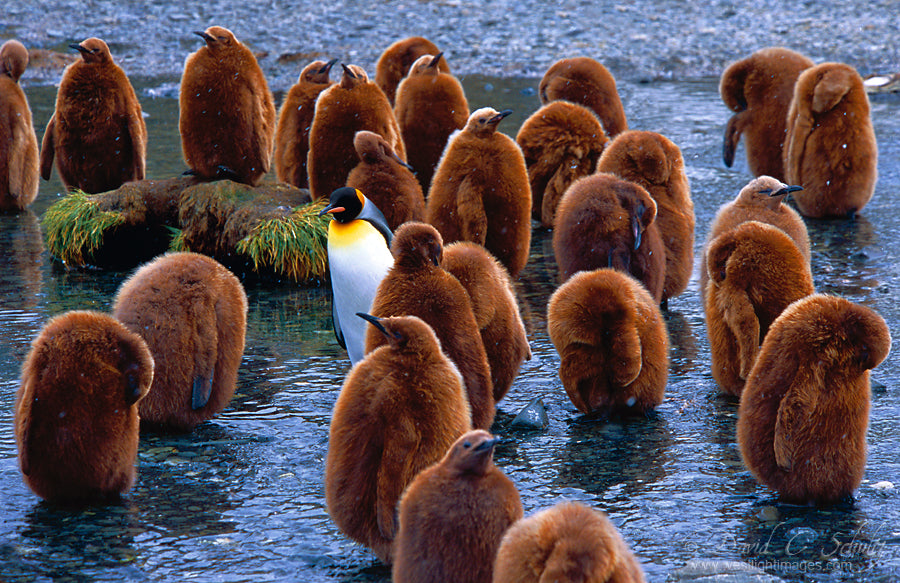I was in a rush, heading out the door with my camera bag one morning when an image appeared on the morning news that would change my life and the direction of my photography in so many ways. It was a black and white photograph of a hauntingly beautiful three masted ship that had been shot in the middle of the night, and it was covered in heavy frost, frozen fast in the ice, and leaning precariously to one side. I stopped to hear the story behind this powerful image, and it was then that I first heard the name Shakleton. They were interviewing Caroline Alexander, the author of a new book titled "The Endurance."
The photographer was Frank Hurley, and the image was one of many he’d captured during the ill-fated Imperial Trans-Antarctic Expedition also known as "The Endurance Expedition" of 1914 with Sir Ernest Shakleton as the leader. The story she told along with other photographs had me hooked as I’d never heard of the expedition, and, to be honest, never had given Antarctica much thought. It was a very cold place down South would have been about the extent of my knowledge I’m sad to say. Later that day I purchased the book, which began my fascination not only in this story, but also in polar travel in general.
I spent that summer reading a number of books about Shakleton, Hurley, and several other explorers and expeditions. The following spring I booked my first voyage to Antarctica and South Georgia Island aboard a Russian research ship named the Akademik Sergey Vavilov, which is currently operated by One Ocean Expeditions. What an experience both for the photo opportunities and also as an education!
During that first trip South I made friends with the expedition leader, a great guy that was also in charge of selecting guest speakers and photographers for these trips. I let him know of my interest in possibly joining other voyages, and that has turned into an opportunity to capture some incredible images. I’ve now sailed to Antarctica and surrounding islands nine times and have traveled the high Arctic photographing six times. Three more voyages are planned for the Arctic this summer including one into the NW Passage. I also bring clients along to both destinations and love sharing the excitement of what I’ve learned.
Focusing on Antarctica: I’ve sailed on several different ships including the Kapitan Khlebnikov, a Russian icebreaker. That was a more specialized trip since we were going to a location called Snow Hill Island in the Weddell Sea and doing so in early October when there is still plenty of sea ice to navigate through. The main goal was to reach an Emperor penguin colony near the island, which required an icebreaker as well as helicopters. Crossing the notoriously nasty Drake Passage is always "interesting," but doing this in an icebreaker with its rounded hull makes for a bumpy and exhausting three days at sea. Seat belts are attached to the beds just in case!
The most visited region of Antarctica is the peninsula, which extends north towards the southern tip of South America. It’s from Ushuaia, Argentina, the farthest south city in the world, that most of the ships depart…and usually return. The shorter voyages are generally around ten days, but my recommendation is to save your money and pay for a longer expedition that includes South Georgia Island. It’s there that you’ll see the King penguins. Nothing can prepare you for your first zodiac landing on a place like Salisbury Plain, which is home to over 200,000 King penguins along with very angry fur seals! My favorite time to head South is in early November, which is the beginning of the season for excursions of this kind.
Depending on the time of year one visits you’ll find a variety of different photo opportunities. Later in the season—February and March—there’s a greater chance to see whales that have migrated South for the abundant food supply. Also, many of the penguin chicks have hatched and can be seen running around, and there’s always a leopard seal waiting just off shore watching for an opportunity for a meal to swim by. Several other species of seals are often seen lying around on the icebergs or on shore, and there’s no shortage of different species of sea birds to keep you entertained as you fill up memory cards.
Along with the wildlife, the ice and landscapes are incredible! Sunsets blend seamlessly into sunrise making for some very long days for shooting. Once you reach the protection of the peninsula the seas are generally very calm, so getting out on the ship’s deck to shoot is easy. Once we reach Antarctica we’re spending most days going ashore at different landing sites or zodiac cruising through iceberg fields. The size, shapes, textures and brilliant colors of the ice still amaze me.










